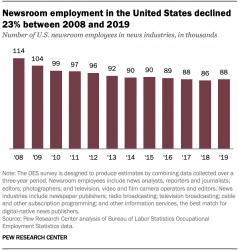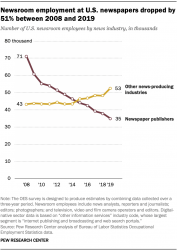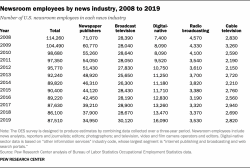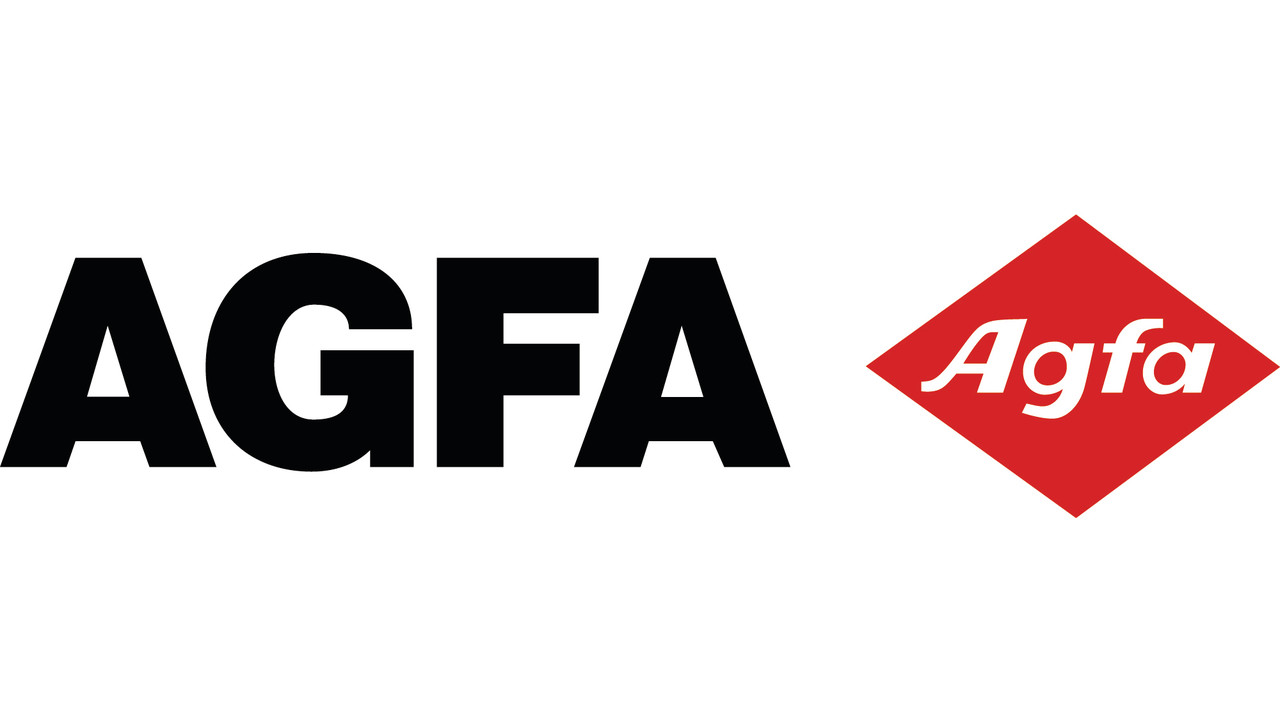U.S. newspapers have shed half of their newsroom employees since 2008

Newsroom employment at U.S. newspapers continues to plummet, falling by around half since 2008, according to a new Pew Research Center analysis of Bureau of Labor Statistics data. But a modest increase in jobs after 2014 in other news-producing sectors – especially digital-native organizations – offset some of the losses at newspapers, helping to stabilize the overall number of U.S. newsroom employees in the last five years.
The years covered in the current analysis predate the spread of the coronavirus in the United States. The economic effects of the virus have led to a fresh round of layoffs, pay cuts and other changes at U.S. media outlets, especially newspapers.
From 2008 to 2019, overall newsroom employment in the U.S. dropped by 23%, according to the new analysis. In 2008, there were about 114,000 newsroom employees – reporters, editors, photographers and videographers – in five industries that produce news: newspaper, radio, broadcast television, cable and “other information services” (the best match for digital-native news publishers). By 2019, that number had declined to about 88,000, a loss of about 27,000 jobs.
How we did this

The bulk of the decline in total newsroom employment occurred in the first half of the period. Between 2008 and 2014, the number of newsroom employees dropped to 90,000, a loss of about 24,000 jobs. After 2014, the number of newsroom employees stabilized, averaging about 88,000 workers through 2019, with little to no change over the five-year period.
The long-term decline in newsroom employment has been driven primarily by one sector: newspapers. The number of newspaper newsroom employees dropped by 51% between 2008 and 2019, from about 71,000 workers to 35,000.
Combined newsroom employment in the other four news-producing industries – broadcast television, radio, cable and digital-native – remained relatively stable, even rising modestly after 2014. Between 2008 and 2014, the number of newsroom employees averaged about 43,000, increasing to about 53,000 by 2019.
This increase of more than 9,000 jobs in the non-newspaper industries nearly offset the loss of about 11,000 newspaper newsroom employees after 2014. However, it fell far short of offsetting the total loss of about 36,000 newspaper jobs over the entire 2008 to 2019 period.
Within each of the five industries analyzed, notable job growth occurred only in the digital-native news sector. Since 2008, the number of digital-native newsroom employees has more than doubled (117%), from 7,400 workers to about 16,100 in 2019. In broadcast television, newsroom employment figures have been relatively stable, hovering around 28,000 between 2008 and 2019. Employment also has remained relatively stable in cable television, between 2,000 and 3,000 over the same period. In contrast, radio broadcasting has lost 23% of its newsroom employees, dropping from about 4,600 workers in 2008 to about 3,500 by 2019. Percentage-wise, this places radio behind newspapers as the industry with the greatest decline, though the overall number of jobs lost – about 1,000 – is 35 times smaller than the loss in the newspaper sector.

The dramatic decline in newspaper employment means the industry now accounts for a smaller portion of overall newsroom employment. In 2008, newspaper newsroom employees made up about six-in-ten (62%) of all newsroom employees. By 2019, the share had dropped to four-in-ten (40%).

Conversely, television broadcasting employees now account for a larger portion of all newsroom employees, rising from 25% in 2008 to 34% in 2019. The proportion for digital-native has tripled over the period evaluated, from 6% of all newsroom employees in 2008 to 18% in 2019.
Of the different types of jobs included in this analysis, reporters made up the bulk of all newsroom employees, representing between 45% and 50% in each year since 2008.
Note: See full methodology here (PDF). This methodology applies to prior years’ analyses and is the same used in this analysis with two changes: 1) the occupation group “news analysts, reporters and correspondents” is now called “news analysts, reporters and journalists;” and 2) “television, video and motion picture camera operators and editors” is now called “television, video and film camera operators and editors.” This is an update of a post originally published on July 9, 2019.
Lire : PewResearch du 20 avril









































